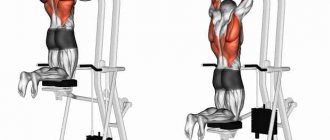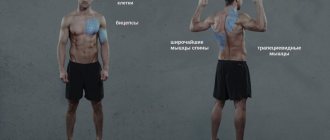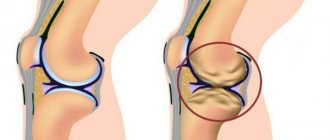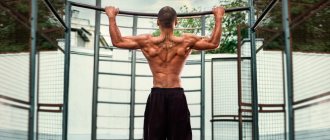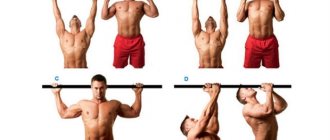Boxing school > > Practice > > 100 pull-ups program
Pull-ups on the horizontal bar are a good and irreplaceable thing. Because this is one of the best and effective exercises for developing the muscles of the back, arms, chest, shoulders, and also the abs in some combinations. Regardless of the grip type, pull-ups have been and remain important exercises for increasing strength, endurance, and are also one of the safest exercises in terms of injury.
What do you need for this? Just a horizontal bar or crossbar. They can be found not only in gyms, but also on outdoor sports grounds and courtyards. Or you can make it even simpler, buy it in a store and hang it in your doorway at home. Save both money and time. But it’s up to you to decide.
Have you finally decided where to start? If you don’t know how to do pull-ups at all or only a couple of times, then first of all, start doing negative pull-ups. Only after you have mastered them, proceed to the usual ones.
And here the main question arises. How to learn to do pull-ups many times in one approach? 20 times, 30, 50...100? This is all quite realistic, the main thing is to set yourself a goal and go towards it. The 100 Pull-Up program will help you achieve this goal. And for motivation, I’ll tell you that the world record was 844 pull-ups. Impressive, isn't it?
What happens if you do 100 pull-ups every day?
To the question of what will happen if you do 100 pull-ups every day, there is only one absolutely guaranteed answer - injury. And not just one, but a whole series, depending on which link (chain) is the weakest. Even if you imagine a theoretical chance of performing such a volume of load per day without injury, the second side effect will be extreme overtraining. As a result, depression of the central nervous system, endocrine system, deterioration of strength and endurance of a number of muscle groups: back, arms, shoulders.
Therefore, you should not follow popular trends and challenges without a clear understanding that achieving results will require a lot of time, effort, injuries and other difficulties. This process, even with a successful combination of circumstances (strong muscles of the limbs and back with low body weight), can take months or even years, especially if the starting point was a result of 8-10 repetitions.
Any programs that promise to teach you how to do 100 pull-ups in 6 weeks are nothing more than media hype and promises that have nothing to do with a person’s physical capabilities.
Which program is better?
The choice of program depends on many factors. For example, an athlete who does 5-7 pull-ups should not start strength training on a horizontal bar with weights. First, he needs to increase the number of pull-ups to at least 10–15.
The genetic characteristics of an athlete are of great importance. Some people have better developed ligaments and tendons, while others have less developed ones. Consequently, training methods and results will be different. In this material we have presented various programs - choose the appropriate training plan. We wish you successful training!
Program for pull-ups 100 times
The whole point of the program is to strengthen and train muscles. And if with the second aspect everything is quite simple and you just need to perform the element with the correct technique, then muscle preparation requires a lot of attention.
Preparation
The main chains that need to be strengthened:
- Skin is the first factor that prevents progress. Even if your back and arms have incredible strength, the skin on your palms will give out long before you can give it your all. Moreover, every torn callus or burst skin means at least 2 weeks of downtime without training until complete healing. Therefore, try to use training gloves, bags (for sliding), a terry towel and other methods to protect the skin of your palms.
- Fingers – often athletes lose their grip and simply “fall out” due to weak fingers. If you want to learn how to do a hundred reps, practice finger hangs and other exercises for your hands and grip strength.
- Using loops is a good way to strengthen your lats, as your arms usually give up before your back. But remember - being too enthusiastic about loops can lead to the fact that without them you will not be able to perform a record number of movements.
- Shoulders are the most vulnerable area. The only way to protect this area is to thoroughly warm up before each bar workout.
- Heart and breathing - improve as it progresses; HIIT routines may be needed for more intense training.
Program methodology
After understanding the essence, you can move on to the main technique. First, you need to learn how to do 10 strict pull-ups in a series, performing at least 3 full sets (rest without a timer and before recovery). After this, you can increase the volumes using the approximate diagram:
- 4*10.
- 5*10.
- 3*15.
- 4*15.
- 5*15.
- 3*20.
- 4*20.
- 5*20.
After this stage, you will be able to do 100 repetitions per day, splitting them into 5 full sets. This is already an incredible result that requires a high level of physical fitness.
When your muscles allow you to perform 5*20 with a break of no more than 5-10 minutes between sets, you can begin to concentrate on performing the maximum number of pull-ups at a time. However, after reaching a certain bar (for example, 40 repetitions), you must apply the same technique to overcome it. For example, doing 3*30, 3*35, 3*40, 4*40. After returning to the maximum amount, as a rule, the one-time maximum will always be higher. In this way, 100 repetitions per set are achieved. But in this case, the decisive factors will be the ratio of muscle strength and endurance to body weight.
Hand position in pull-ups
As a rule, pull-up programs involve the use of a classic straight grip - the palms are turned away from you and slightly wider than the shoulder joints.
In fact, by changing the position of the hands on the bar, you can increase or decrease the load, as well as shift the emphasis in the exercise from one muscle group to another.
Let's briefly look at popular grip options:
- Straight . Palm position: turned away from you and slightly wider than shoulder-width apart. With this grip, the biceps brachii, forearm, delta, and latissimus muscles are evenly loaded.
- Reverse . Position of the palms: turned towards you and spaced at the width of the shoulder joints. The emphasis of the load shifts to the biceps of the arms, and the lats are additionally involved.
- Different grip . The position of the palms is: one is turned towards you, the second is turned away from you. The distance between the brushes is small. The biceps and anterior deltoids are mainly loaded.
- Narrow . Palm position: turned away from you and brought close to each other. When performing pull-ups this way, the lower lats, biceps, and anterior deltoids are worked out.
- Wide . Palm position: turned away from you and spread wide (80–100 cm). Pull-ups work the lats, biceps, and a little bit of the pecs. When pulling up behind the head, the trapezius, lats, and biceps are included.
- Parallel . Palm position: facing each other (a special horizontal bar with narrow parallel stops is used). The main load is taken by the biceps; the lats and brachialis work additionally.
The effectiveness of training on the horizontal bar can be increased by using pull-ups with different grips in one program. The torso muscles will be more fully involved, and this will allow you to quickly achieve your goals in developing an athletic physique.
Don't forget about the lower body. To develop your figure harmoniously, add various squats, lunges, deadlifts, and plyometric elements to pull-ups. Such exercises will help to form developed muscles of the legs and buttocks.
Recommendations
The progression in the task itself looks simple and fairly linear. The main difficulty is to “tighten up” all the weak links and reduce the risk of injury to a minimum. Key recommendations for the weakest points:
- If your wrists are lagging, use explosive pull-ups at a fast pace to strengthen your grip and the lagging link. Also, when doing an explosive pull-up, the lowering of the body down should be slow.
- When knocking down the breather, it is necessary to regulate the pace; this is a matter of insufficient preparation.
- If the main problem is not your hands, but weak back muscles or long arms, practice a wider grip. It creates an increased load on the hands, but narrows the amplitude in order to bring the chin beyond the level of the bar.
- Pull-ups in a slow style (or with a delay of 2-3 seconds at the top) also help strengthen almost all the muscles of the upper body.
In addition to all other factors, the prerequisites for achieving results are nutrition (plenty of protein, sufficient carbohydrates, healthy fats), quality sleep and the absence of severe fatigue during the day: work, stress and other factors.
Pull-ups for advanced
- If you easily hang on two at the top and can hang like that forever, let go of one hand.
- Do the second exercise for speed on slightly bent arms from a hanging position.
- And replace the third with pull-ups on straight arms with shoulder blades on a high horizontal bar. The body rises forward up to 90 degrees. The horizon is hanging.
We vary the load by speed and number of approaches.
Remember, we pull towards the chest or stomach, not the chin.
And of course the pull-ups themselves. Once you have them, start doing full pull-ups.
Positive reinforcement and self-reinforcement
As soon as you have the smallest first result, share it with those who support you. Tell and show them how important their support is to you. Keep a diary of your workouts. Now this can be done publicly on social networks. Use the hashtag #Combat Academy
Don't be afraid of negativity. Don't argue or argue with idiots. Just block. Stay strong and listen to whoever is supporting you. Express your sincere gratitude to such people.
And of course, reinforce yourself. Every success you have is a victory! So nourish yourself with what you love. Give me candy or sugar. Do it right away, at the moment of your victory.
This will help strengthen your Champion skill.
What not to do
- You can't punish yourself for things that don't work out.
- You can’t be negative and not believe in yourself
- You can’t read negative comments, just delete them as soon as you understand what the monkey is writing about
- You can't be negative offline. Block negativity with your smile and humor
- You can’t walk past the horizontal bar and not do some pull-ups, especially if you’re going to the refrigerator. First he pulled himself up - then he ate the marozhka.
I hope my tips will help you increase your pull-ups on the horizontal bar, even if you can’t do pull-ups at all right now.
PS Do you need a competent and correct trainer? Write, call +7 915 547 91 61 Extensive work experience, including via the Internet. Yes it is possible. The first consultation is always FREE >>>
Types of grips when pulling up
In general, the pull-up technique is identical, but the group of muscles being worked depends on the type of grip chosen. Let's look at each of them.
The classification is presented in two categories:
- distance between hands: medium, narrow or wide;
- way to grip the bar: direct, reverse and neutral.
Narrow grip
Close grip pull-ups. The figure clearly shows that the hands are located close to one another.
With a narrow grip, the hands are positioned at a distance less than the width of the athlete’s shoulders. This exercise pumps up the muscles of the biceps and forearm. The closer the hands are to one another, the greater the load.
We also recommend studying this topic:
How to pump up your biceps with a kettlebell at home?
25202 0 0
Medium grip
With a medium grip, the distance is equal to shoulder width. It is the most optimal, since the load is distributed evenly. At the same time, the muscles of the arms, as well as the shoulders and back work.
Exercise - medium grip pull-up. The most common exercise among athletes. Hands strictly shoulder width apart
Wide grip
With a wide grip, the distance is greater than shoulder width. The back muscles are worked out perfectly.
A wide grip when doing pull-ups helps you work many muscles at the same time. The picture illustrates this. As you can see, the arms are positioned wider than the shoulders
Advice! To increase the load, the arms are placed as wide as possible and the thumb should not cover the bar.
Straight grip
This is a grip when the palms of the hands are turned away from the face. It also has names: pronated or upper.
Straight-grip pull-ups are a great exercise for working a variety of muscles. With an average and at the same time straight grip, the load is uniform
Reverse grip
This grip is done from below, with the palms facing the athlete's face. Another name for it is supinated. The athlete's body is parallel to the crossbar.
Reverse grip pull-up. The figure shows the muscles that work when performing this exercise.
Neutral grip
You need to stand perpendicular to the bar and grab it with both hands. You need to pull yourself up to the level of your chin, moving your head slightly to the side. Some horizontal bars, in addition to the crossbar, have additional handles located in parallel. This will also be a neutral grip.
Neutral grip pull-ups. It is clearly visible that the crossbar is grasped on both sides and the body turns perpendicularly. The load in this exercise is not very heavy.
This material will be perfectly complemented by the following publications:
- When choosing yoga, choose the right ASANA
- Swimming crawl: features of proper technique
Contraindications to pull-ups on the horizontal bar
Exercising on the crossbar does not have a large list of restrictions; they come down to a list of diseases for which no strong physical activity is recommended.
And this:
- Diseases and disorders of the cardiovascular system.
- Diseases of the lungs or respiratory system.
- Disorders of the gastrointestinal tract.
- Diseases of the kidneys (stones in them) and liver.
- Curvature of the spine (or herniated discs)
- Recovery periods after operations.
The presence of osteochondrosis in a person is not a direct contraindication, but if it is detected, pull-ups should be treated with caution. On the one hand, they help restore vertebral mobility and increase blood circulation, on the other hand, they put great pressure on degenerative changes in the spinal column.
Women with a lot of weight should refrain from doing pull-ups until they are as low as possible. Doing this exercise with heavy weight can cause serious injury.
